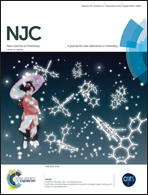Binding of a potential anti-hepatoma drug cis,cis,trans-[Pt(NH3)2Cl2(O2CCH2CH2COOH)-(OCONHC16H33)] with serum albumin – thermodynamic and conformational investigations†
Abstract
In this paper, a potential anti-hepatoma Pt4+ drug cis,cis,trans-[Pt(NH3)2Cl2(O2CCH2CH2COOH)-(OCONHC16H33)] was synthesized and selected to investigate its binding to human serum albumin (HSA) by spectroscopy and molecular docking methods. Fluorescence spectra show that the Trp residue, the intrinsic fluorophore in HSA, was induced to a less hydrophobic microenvironment with the addition of the Pt4+ compound, which induces the denaturation of HSA. Moreover, the fluorescence quenching mechanism was determined to be static quenching. The binding constant (KA) and the number of binding sites (n) were calculated based on the results of fluorescence measurements. Circular dichroism (CD), Fourier transform infrared spectroscopy (FTIR) and three dimensional fluorescence spectroscopy proved that the Pt4+ compound could slightly change the secondary structure and induce unfolding of the polypeptides of protein. Thermodynamic parameters indicate that the Pt4+ compound binds to HSA through electrostatic attraction with one binding site. The molecular docking study indicated that parecoxib is embedded into site I (subdomain IIA) of HSA.
![Graphical abstract: Binding of a potential anti-hepatoma drug cis,cis,trans-[Pt(NH3)2Cl2(O2CCH2CH2COOH)-(OCONHC16H33)] with serum albumin – thermodynamic and conformational investigations](/en/Image/Get?imageInfo.ImageType=GA&imageInfo.ImageIdentifier.ManuscriptID=C5NJ01103E&imageInfo.ImageIdentifier.Year=2015)

 Please wait while we load your content...
Please wait while we load your content...